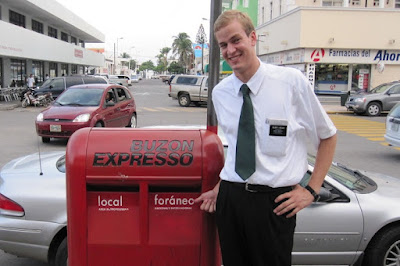Every once in a while, missionaries find what they call “golden investigators” (in Spanish, “investigadores de oro”). Golden investigators are those few people that are very receptive to the missionaries’ message. They already feel a drive to find true doctrine, so when you teach them, they don’t need much convincing or persuading. They take responsibility for their own conversion and often become strong members of the church after joining. This is the story of one of the first such people I met as a missionary.
But for context, let me first give a little background about what missionaries teach during their first lesson with a new investigator. At the end of that initial lesson, missionaries usually explain about the Book of Mormon. We believe that the Book of Mormon is an ancient record that was written on plates made of gold by prophets that lived in the Western Hemisphere. One of the last prophets to write in the book, and the one that compiled it from the writings of other prophets, was named Mormon. His son, Moroni, finished writing in the record and then hid it in the ground for several centuries. In the 1820s, Moroni appeared, now as an angel, to Joseph Smith, who retrieved the gold plates and then translated them by inspiration from God. The resulting translation was published as the Book of Mormon. Members of the church consider both the Bible and the Book of Mormon to be divine scripture.
Needless to say, many people investigating the church are unfamiliar with the Book of Mormon, and they can be skeptical of the account of where it came from. So what missionaries usually do is ask investigators to take a Book of Mormon and read it on their own, after the missionaries have left. Then they ask them to pray and ask God whether the Book of Mormon is true. We believe that if they’re sincere, God will help each person feel and know for themselves that it’s real. When investigators come to believe that the Book of Mormon is true, it helps them have confidence in all the other new ideas that missionaries teach them and ask them to do. So missionaries are always trying to get people to try reading the Book of Mormon for themselves.
Unfortunately, even among the relatively few investigators that were interested in having us visit them again, it was fairly rare that they had read and prayed about the section of the Book of Mormon that we’d left for them. I think that missionaries frequently get so caught up explaining the Book of Mormon’s miraculous origins that they tend to gloss over the invitation to read it and the significance of knowing whether the book is what we say it is. Whatever the reason, we typically had to teach investigators several lessons before they really understood how important it was that they read and pray about the Book of Mormon on their own. So when we found an investigator that did read it, they really caught our attention.
Mayra was one of these golden investigators. I don’t remember how we found her originally, but she lived in La Reserva with her mother and her toddler son. We taught her a fairly typical first lesson and gave her a Book of Mormon, asking her to read a specific chapter. We also invited her to attend church with us the following Sunday, which she said she would do. We set an appointment to come back a few days later.
As it turns out, Mayra not only came to church without us arranging a ride for her, but she also brought her mother along, too. And when we went back to teach her again, she told us that she read the chapter we assigned twice through to make sure she understood it well and then taught her mother about everything she’d learned during our first visit. Elder Nájera and I were blown away; I don’t think I’d ever had an investigator take such a quick interest in what we were teaching before. We asked Mayra what she thought of the Book of Mormon. She told us that while she was reading it, she could feel that it was true. We explained the connection between the truthfulness of the Book of Mormon and that of the church. Then we taught about the importance of baptism and the process of how God had given his authority to the restored church to perform baptisms and other ceremonies. And then we asked the question—would she let us help her prepare to be baptized in the church? She accepted without hesitation. We were ecstatic.
Over the next couple of weeks, we taught lots of lessons to Mayra and her mother, who also had become interested in the church. Giving the lessons was a breeze, and when Mayra finally got baptized, I didn’t even feel like I could take any credit for teaching her; it was clear that she’d done almost all the work herself. Even so, it felt great to know that she would become the newest member of the ward.

No comments:
Post a Comment